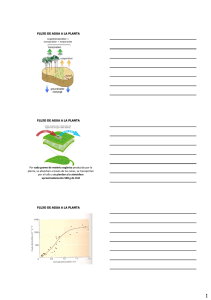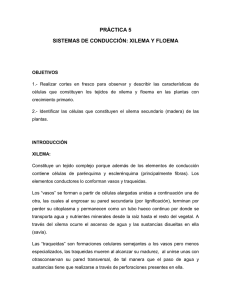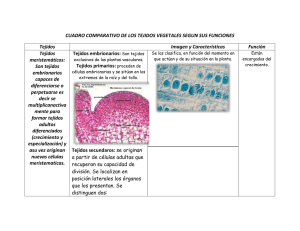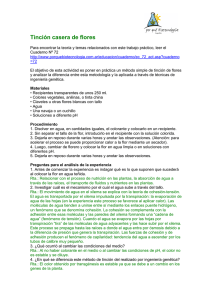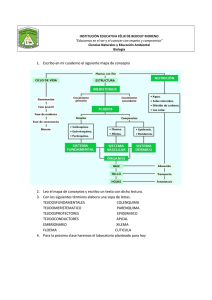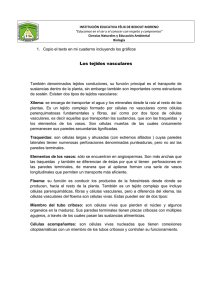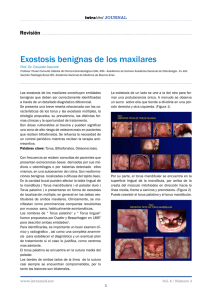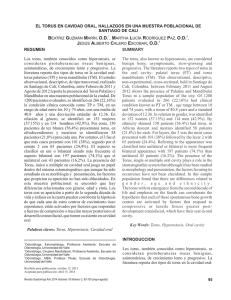Tema 6: Xilema • Desarrollo del xilema: • crecimiento primario
Anuncio
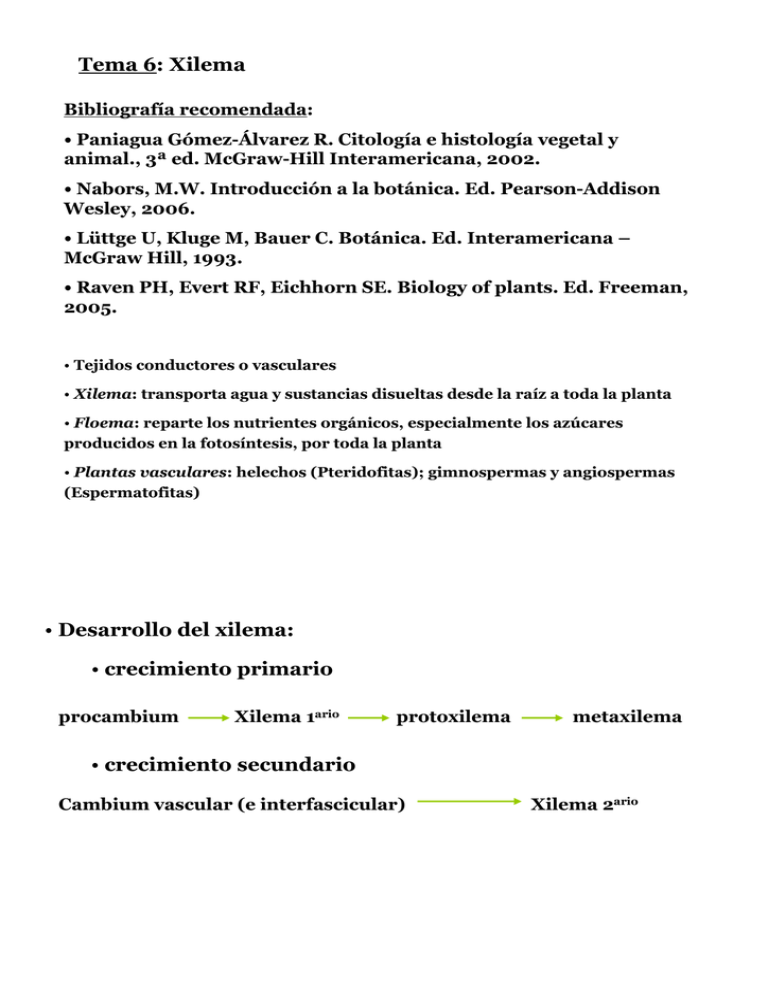
Tema 6: Xilema Bibliografía recomendada: • Paniagua Gómez-Álvarez R. Citología e histología vegetal y animal., 3ª ed. McGraw-Hill Interamericana, 2002. • Nabors, M.W. Introducción a la botánica. Ed. Pearson-Addison Wesley, 2006. • Lüttge U, Kluge M, Bauer C. Botánica. Ed. Interamericana – McGraw Hill, 1993. • Raven PH, Evert RF, Eichhorn SE. Biology of plants. Ed. Freeman, 2005. • Tejidos conductores o vasculares • Xilema: transporta agua y sustancias disueltas desde la raíz a toda la planta • Floema: reparte los nutrientes orgánicos, especialmente los azúcares producidos en la fotosíntesis, por toda la planta • Plantas vasculares: helechos (Pteridofitas); gimnospermas y angiospermas (Espermatofitas) • Desarrollo del xilema: • crecimiento primario procambium Xilema 1ario protoxilema metaxilema • crecimiento secundario Cambium vascular (e interfascicular) Xilema 2ario • Componentes del xilema: • Elementos vasculares • Tráqueas (vasos). • Traqueidas. • Elementos no vasculares • Parénquima axial y radiomedular • Fibras esclerenquimáticas (fibras del xilema) Tráqueas • En angiospermas (mono y dicotiledóneas) y algunas gimnospermas y pteridofitas. En el resto sólo traqueidas. • Como vasos conductores: • Facilitar la entrada y salida del agua en los vasos. • Evitar el colapso del vaso por las diferencias de presión al vaciarse. • Además, función de sostén. • Tamaño: 10 cm de longitud y 0,1 mm de espesor. Tipos de Tráqueas • Xilema primario: • Protoxilema: Anilladas. Engrosamientos en anillo. Helicadas. Engrosamientos en hélice. Doble-helicadas. Engrosamientos en doble hélice. Anulo-helicadas. Además de una hélice hay anillos. • Metaxilema: Escaleriformes. Engrosamientos como peldaños Reticuladas. Engrosamientos con mayor extensión, red irregular. Punteadas. Descubiertas zonas muy pequeñas. Traqueidas • En xilema de todas las plantas (en las que no tienen tráqueas, son los únicos elementos del xilema) • Similares a tráqueas en estructura y función, pero… • Cada traqueida es más estrecha y más larga que un elemento de tráquea. • Las paredes entre traqueidas no están perforadas sino llenas de punteaduras. •Mayor resistencia a la conducción de agua, pero más protección a la extensión de émbolos. Parénquima del xilema • Caracteres generales de las células parenquimatosas, realizan intercambios con los elementos vasculares (aa, hormonas, sales minerales, etc.) • Clasificación • En Xilema primario: células alargadas en sentido longitudinal del órgano • En Xilema secundario: • Parénquima axial. • Parénquima radiomedular. Fibras del xilema • Elementos de sostén de tejidos vasculares. • Se asemejan a traqueidas, pero son más largas y paredes más gruesas • Proceden del procambium o del cámbium Tílides • células parenquimáticas que se introducen en el interior de tráqueas y traqueidas • permiten bloquear la luz del vaso impidiendo que ésta sirva de túnel para el desplazamiento de hongos Desarrollo del xilema crecimiento primario procambium Xilema 1ario protoxilema metaxilema • pocas tráqueas y mucho parénquima • madura antes de alargamiento del órgano en tallos y hojas: se destruye. • más tráqueas y más gruesas (más lignificadas • completa su maduración al terminar la elongación: no se destruye. crecimiento secundario Cambium vascular (e interfascicular) Xilema 2ario • metaxilema deja de ser funcional • en clima benigno tráqueas y traqueidas pueden ser funcionales varios años. • xilema 2ario crece formando radios, que afectan a elem. vasculares, parénquima axial y radiomedular. • diferencias de volumen en primavera-otoño: anillos de crecimiento anuales. Longitudinal section of club moss (Lycopodium). Fig. 7.2-3 shows that club moss has narrow tracheary elements with annular secondary walls; it also has narrow tracheids with scalariform pitting. Transverse section of pine wood. This high magnification view of pine tracheids shows several circular bordered pits cut in transverse section. The pale pink region that arcs into the tracheid lumen is the pit border. The dark, almost black bar is the torus; in all these pits, the torus is pressed against one side of the pit. Having the torus to one side like this indicates that the wood had suffered from water stress and the water columns had cavitated (broken); When the water rushed from the cavitating cell to the still functional one, the rapid flow pushed the torus against the inner aperture where it became stuck. The displacement of the torus seals the pit and prevents air from passing into the water-filled tracheid, thus preventing the embolism from spreading. Longitudinal section of pine wood (Pinus). All cells shown here are tracheids, and all the circular structures are circular bordered pits. The outer white area is known as the margo, the inner dark area is the torus. The margo is an area where the pit membrane is very thin, partially digested away in some species such that water passes relatively easily through it. The torus, in contrast, is a thickened area that can seal off the pit if one of the tracheids becomes filled with air. Transverse section of vascular bundle of sunflower (Helianthus). This bundle contains tracheary elements of many different sizes, but they all are large enough that they are probably vessel elements rather than tracheids. Also, since this is an angiosperm, tracheids would are not so common. The tracheary elements at the lower part of the bundle are smaller (known as protoxylem), those at the top are larger (metaxylem). An important point here is that all these tracheary elements are much larger than all surrounding cells. Transverse section of wood of Ilex opaca (American holly, a dicot or hardwood) Each of the double-headed arrows on the left indicate an annual ring. The lower head of each arrow is near the earlywood, the upper head is near latewood (by common agreement, transverse sections of wood are shown with the younger rings near the top, as if the vascular cambium were somewhere above the top of the micrograph). The vertical red stripes are rays, and altogether they make up the ray system of wood. Between the rays are masses of fibers and vessels; these masses make up the axial system of wood. Even at this low magnification, it is possible to see significant detail in the vessels: they are present (so this cannot be a conifer), they are uniformly distributed within each annual ring (so this wood is diffuse porous), and all vessels are approximately the same size without any being extremely wide or narrow. Transverse section of wood of Thuja occidentalis (American arbor-vitae, a conifer or softwood). The double-headed arrow indicates a single thick annual ring. Rays are narrow and rather far apart, and the axial system of the wood consists of just tracheids, with no fibers (that is why conifers are called “softwoods”) and no vessels. The latewood tracheids make up a relatively narrow band of darker red cells – they are dark because their secondary walls are thick and therefore stain intensely. Earlywood tracheids make up almost all the annual ring, and they have such thin secondary walls they do not take up enough stain to be dark red.
